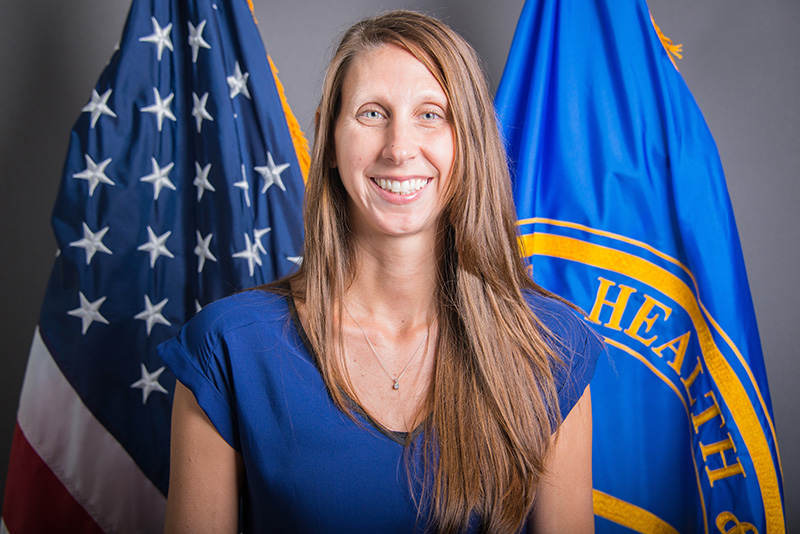A safe approach
Alumna recognized for her work through CDC to improve mining safety

Emily Haas has long had a passion for safety.
That passion took her to the mining community as a senior research behavioral scientist for the Centers for Disease Control’s National Institute for Occupational Safety and Health.
During her time at Purdue, her safety efforts focused on motorcycle riders.
“She was my right-hand person on the motorcycle safety campaign research team, and she was so motivated,” said Marifran Mattson, head of the Brian Lamb School of Communication. “We both had related experiences. I lost my leg in a motorcycle accident, and there was a death of someone close to her from another motorcycle accident. When the work led to the first motorcycle caution sign going up, it was a great accomplishment and a great feeling.”
For Haas – who completed a Ph.D. in Health Communication at Purdue in 2012 – that small sign symbolized what can be accomplished by combining research, effort, and a genuine concern for others. And it was only the beginning.
Through a former colleague of Mattson’s, Haas landed an interview with the National Institute for Occupational Safety and Health, which led to a job offer.
While motorcycling and mining might not seem to have much in common, for Haas it was all about safety – and the needs of others.
“There was a gap that existed in this particular industry,” she said.
Though the mining industry has gone through its share of changes, the most recent data from the Mine Safety and Health Administration indicates that there were nearly 200,000 employees in 2017 at approximately 13,000 operating mines. In other words, research is still vital to ensure safety for this hard-working community.
Haas received new miner training and went on to receive annual field training, and much of that education was voluntary.
“It doesn’t make you a miner, but it helps you learn what miners go through,” she said. “A lot of my day is going through a research process involving data collection, and ultimately communicating with companies and stakeholders to disseminate what the research findings are and what it means to them and workers.”
Her research has focused on everything from the effect of dust assessment technology to the importance of employee communication.
Haas’ work, which has taken her to roughly 50 mines in 25 states, has revealed something that might come as a surprise.
“I have been underground dozens of times when it comes to mines,” she said. “What I learned, and what many people don’t know, is it’s actually a safe industry and safer than people think. Companies are improving their systems and processes and really making an effort.”
Haas finds going to the mine sites a valuable learning experience, particularly seeing the different mining processes that exist depending on the commodity involved: clay versus coal, coal versus gold, and so on. Each is different, and each sector carries its own risks.
Haas also benefits from spending time with mine workers and getting a sense of their concerns.
“Whenever I deal with them, it’s humbling because they work in a dynamic environment where they have to adjust and have foresight,” she said. “People don’t understand all of the checks they go through before they start their day. It’s not just industry safety precautions, but worker awareness that makes the difference.”
In the six years she has worked for the National Institute for Occupational Safety and Health, Haas has been proud to see her contributions help companies make sustainable changes to safety culture at mine sites. “We have found that the biggest predictor of following rules is an intervention by a co-worker,” she said. “It’s about assessing what the communication is on site and where can it be improved. … Another topic focused on is giving workers more autonomy on the job to make decisions.”
Her work was even recognized in June 2018 with an Arthur S. Flemming Award in the category of Social Science, Clinical Trials, and Translational Research. Presented by the Trachtenberg School of Public Policy and Public Administration at George Washington University, the prestigious award recognizes outstanding federal government employees.
In accepting the Flemming Award, Haas joined a list of recipients that includes pioneering physicians, award-winning journalists, senators, and Purdue’s most famous alumnus, astronaut Neil Armstrong.
“It was unexpected and exciting to be recognized,” Haas said. “Where I work it’s about 90% engineers, but much of my job is about explaining things, and it’s not about developing technology. It’s contributing to health and safety, but in a different way. It felt great that an external committee recognized the years of travel and work.”
Even as time passes, Haas still feels a strong connection to her Purdue days – particularly to mentors like Mattson.
Through their partnership conducting motorcycle research, she learned a valuable lesson that still applies to her work today. Maybe they did not see a total behavior change as a result of their findings, but they did observe improvements in knowledge and awareness.
Today, Haas understands that people might not always follow the safety guidelines that experts suggest. However, they might be willing to at least make some improvements if you deal with them respectfully